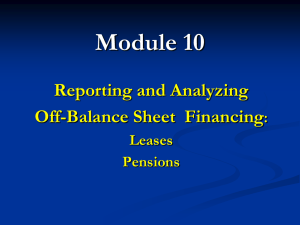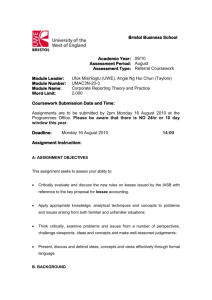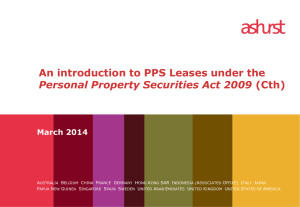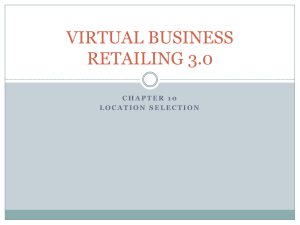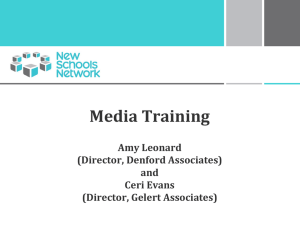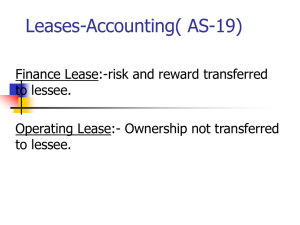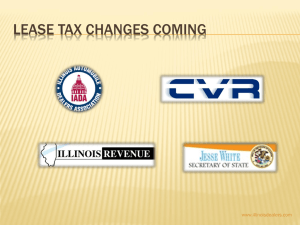Sample Module (continued) - My Accounting & Finance Community
advertisement
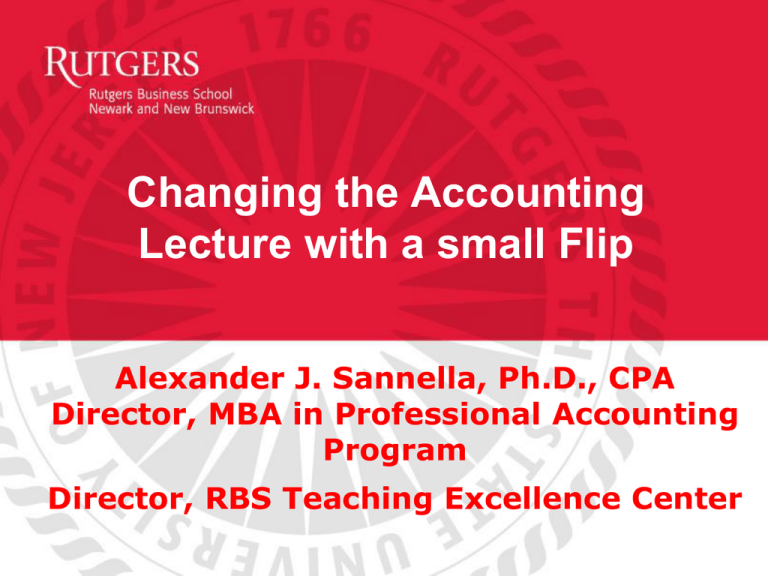
Changing the Accounting Lecture with a small Flip Alexander J. Sannella, Ph.D., CPA Director, MBA in Professional Accounting Program Director, RBS Teaching Excellence Center Old Dog wants to learn new tricks. Why? • Teaching ratings still good but declining. • Mega-lecture format coming in the fall (Rutgers Big 10 peer schools) • The three “knock down rule” in New Jersey. • Lack of student preparation and participation and most students are clearly not engaged • A bad case of laryngitis • Pearson conference call: Can we deliver material in small doses? • My daughter, a recovering CPA. Flipped Classroom • Nothing new in education but it is new to me. • Uses blended learning where students are required to read material, watch short videos-followed by a series of on-line quizzes. • In-class time is devoted to exercises and discussion of the video and other material and quizzes. Guest speakers can also be used during class time. • Instructors are supported by teaching assistants in large lectures. • Can it work in accounting? Penn State is typically sited as a successful example (covers 1,300 accounting students). Flipped Classroom (continued) • Class time is also devoted to the application of concepts which enables the instructor to identify student errors in thinking and understanding. • Classroom discussion and the use of technology is critical. • The major issue for instructors is that this format will require a great deal of time to re-tool courses and course preparation time is increased. • Covering exercises and class discussion will quickly consume traditional lecture time-so topics may have to be removed from the curriculum. • Alternatively, assigned videos can be used to cover these topics with little or no class discussion. Flipped Classroom (continued) • The major issue for students is that they must be prepared for every class session. Students often complain if there is a total lack of face-to-face lecture time. • Frequent feedback should be used to assess learning and student satisfaction with the format used (weekly surveys can be used). • Class participation must be a significant portion of a student’s total grade (15% to 20%). Students frequently complain about the “subjectivity” of the grade earned. A Small Flip for Starters • A Compromise: Use a blended approach with some lecture time included. • Student responsibility includes: 1. Preparation of mini-lectures and answering a series of questions that will be discussed in class. The minilectures will be presented in part by the instructor. 2. The material contained in the mini-lectures are in the form of 10 to 15 page “Modules” using Word files (PowerPoint could also be used). 3. The textbook is a supplement. 4. Watching videos for topics that will not be presented by the instructor. A Small Flip for Starters (continued) • In addition to the questions contained in the minilecture material (modules), students must be fully prepared to answer other questions (“on the fly”) and participate in class discussions. • In all cases, questions are asked periodically throughout the mini-lecture as well as at the end of the module. • Students discuss the questions in small, informal groups and respond using a SRS (Student Response System or clickers). • Cell phones, laptops or iPad have the capability to be used as clickers. A Small Flip for Starters (continued) • Depending on the responses to the questions asked after the discussion, the instructor can determine if material has to be covered again or in more depth. Sample Module CHAPTER 21: ACCOUNTING FOR LEASES Module 21-4 Module Contents • Key lease disclosures for the lessee. • Analytical capitalization of operating leases for the lessee. • Lease Accounting Standards Update (ASU) proposal (Online Video in Blackboard) Sample Module (continued) Lessee Disclosures • Required disclosures for the lessee are extensive under both US GAAP and IFRS. • These disclosures are designed to provide the reader with information regarding the relevant assets and obligations under finance leases as well as the “off balance sheet obligations” that may exist for the lessee under the operating lease method. • A sample lease disclosure is presented below. Sample Module (continued) Sample Lease Disclosures: Lease Footnote Disclosures (10) Lease Obligations TAL Airlines, Inc., leases aircraft, airport passenger terminal space, aircraft hangars and related maintenance facilities, cargo terminals, other airport facilities, other commercial real estate, office and computer equipment and vehicles. At December 31, 2012, scheduled future minimum lease payments under capital leases (substantially all of which are for aircraft) and operating leases having initial or remaining noncancelable lease terms of more than one year were as follows: Sample Module (continued) (In millions) Payable during 2013 Operating Leases Aircraft Non-aircraft $ 782 $ 489 Capital Leases $ 177 2014 785 459 246 2015 761 445 314 2016 725 435 209 2017 696 422 433 2,691 3,432 637 $ 6,440 $ 5,682 $ 2,016 After 2017 Total minimum lease payments Imputed interest (at rates of 1.5% to 10.0%) Present value of minimum lease payments Current portion Long-term obligations under capital leases (263) 1,753 (20) $(1,733) Sample Module (continued) • As of December 31, 2012, we leased 230 mainline aircraft, 57 of which were under capital leases. • Amounts charged to rent expense, net of minor amounts of sublease rentals, were $1.0 billion in 2012, $1.1 billion in 2004 and $1.2 billion in 2003. Sample Module (continued) • ANALYTICAL IMPLICATIONS-CAPITALIZATION OF OPERATING LEASES FOR THE LESSEE. • To consider the effects of "off-balance sheet financing," financial and credit analysts have developed techniques that would "capitalize operating leases" for the lessee. This is known as constructive or analytical capitalization. That is, estimates of the lease obligation and debt service (i.e., interest expense) are calculated by the analyst. These estimates are included in the analysis of pro forma or projected financial statements. Sample Module (continued) • Various rules of thumb have been developed by rating agencies (e.g., Moody's and Standard and Poor's) to capitalize operating leases. For example, the lease obligation is estimated from the lease footnote information by using 7 or 8 times rent expense. The interest expense is computed as 1/3 rent expense and depreciation is estimated as 2/3 rent expense. • Today, many rating agencies are using the information provided in the lease footnote to employ a discounted cash flow approach in estimating the off balance sheet lease debt for operating leases. Sample Module (continued) Summary of Capitalization of Operating Leases • Various rules of thumb have been developed by rating agencies (e.g., Moody's and Standard and Poor's) to capitalize operating leases. These rules of thumb were originally designed for real estate leases, the most common type of lease arrangement at that time. • At that time, multipliers as high as 10 times rent expense were used to proxy the capitalized lease debt. This was designed to capture the interest rates and terms of the real estate debt. Therefore, using a multiplier of 10 was viewed as a representative present value factor for real estate leases. Sample Module (continued) • Specifically, this rule of thumb was developed from Real Estate Capitalization Rates. • For long term real estate leases, the term can extend 40 years. In this case, the number of periods in a discounted cash flow application would go to infinity (in perpetuity) • As n ∞, the discount factor approaches 1 / i (where i is the capitalization rate). So if the current rate is 12.5% = 1/8, then the capitalized lease value is computed as follows: Sample Module (continued) Capitalized Value = Rent Expense x 1 / i = = Rent Expense x 1 / .125 = Rent Expense x 1/ (1/8) = Rent Expense x 8 Sample Module (continued) The Discounted Cash Flow Approach • The DCF approach better utilizes the lease footnote disclosure by estimating the "off-balance sheet" lease obligation as the present value of the future minimum lease payments. • The key variable in this calculation is the determination of the interest (discount) rate to use in the present value (discount) calculation. • One alternative is to use the weighted average interest rate obtained from the long term debt footnote. Another alternative is to estimate an average discount rate from the information provided for capitalized leases. Sample Module (continued) • The discounted value is the analysts' estimate of the long term lease obligation for operating leases. With this information, a parallel analysis can be made to compare the true capital leases and the capitalized operating leases. • The capitalized leased asset is generally not created on a pro forma basis. • It should be noted that this method, as well as the rating agency rules, are conservative approaches. Both methods assume that all operating leases were misclassified and in substance should have been recorded as capitalized lease obligations. • An illustration using a sample lease footnote is presented below. Sample Module (continued) SAMPLE DISCLOSURES: Future minimum lease payments, by year and in aggregate under non- cancelable operating leases, were the following at December 31, 2011: Sample Module (continued) For the years ended December 31 2012............................................ 2013............................................ 2014............................................ 2015............................................ 2016 ............................................ 2017 and thereafter........................ Total minimum lease payments...... Amount $300,000 200,500 100,000 80,000 75,000 400,500 $1,156,000 Sample Module (continued) Applying Analytical Lease Capitalization Real Estate Capitalization Factor: 2011 Lease Debt: Rent Expense x 7 = $450,000 x 7 = $3,150,000 Discounted Cash Flow Approach: • Assume Cost of Debt Capital is 10% Sample Module (continued) Year 2012 2013 2014 2015 2016 2017 and Thereafter: Total Convert to an annuity due Capitalized Lease Debt Lease Payment $300,000 200,500 100,000 80,000 75,000 400,500 Discount Factor @ 10% for an amount of $1 .90909 .82645 75132 .68301 .62092 .56447 Present Value $272,727 165,703 75,132 54,641 46,569 226,070 $840,842 X 1.10 $924,926 Sample Module (continued) • Proposed changes in lease accounting. • Watch video and use accompanying PowerPoint slides. Both are in course documents on Blackboard. • https://blackboard.newark.rutgers.edu/webapps/portal/fram eset.jsp • Videos produced on Camtasia 2 and uploaded to Blackboard. Sample End of Module Questions End of Module 21 – 4 Questions True and False and Explain • Required lessee disclosures allow a financial statement user to capitalize operating leases. • The capitalization of operating leases will impact the current ratio, the debt / equity ratio and times interest earned ratio. • The proposed lease standards will result in having the leased asset on the books of both the lessor and the lessee. • The proposed lease standards will result in lower EBIT, EBITDA and net income for the lessee. Classroom Discussion • Use of technology: Student Response Systems or clickers. • Turning Technologies-Clickers have to be purchased for about $40 and the school must purchase the USB Receivers for each instructor ($200). • Top Hat Monocle-Students can use their cell phones, laptop, iPad, etc., as the clickers and can answer questions directly on their mobile device. • Here’s more information on Top Hat Monocle. https://www.tophatmonocle.com/ Ice Breaker Questions-Disguised attendance 1. You just finished attending the Maroon 5 concert at Revel. How many members are in the pop group Maroon 5? a. Four b. Five c. Six d. Seven Ice Breaker Questions-Disguised attendance Ice Breaker Questions-Disguised attendance (continued) 2. Did you know the answer or did you guess? a. Yes b. No Ice Breaker Questions-Disguised attendance (continued) 3. If you guessed, did you select the correct answer? a. Yes b. No Questions?
